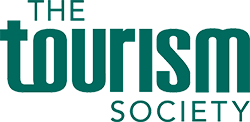The 70-year story of a preserved bus – Leicester City Transport 154 – FJF 193 – by Stuart Render.
The morning of Saturday 13 August 1983 dawned clear and bright. But whilst the weather wasn’t anything special, the day itself was one of the most memorable days of my life. It was the day I would drive FJF 193 for the first time.
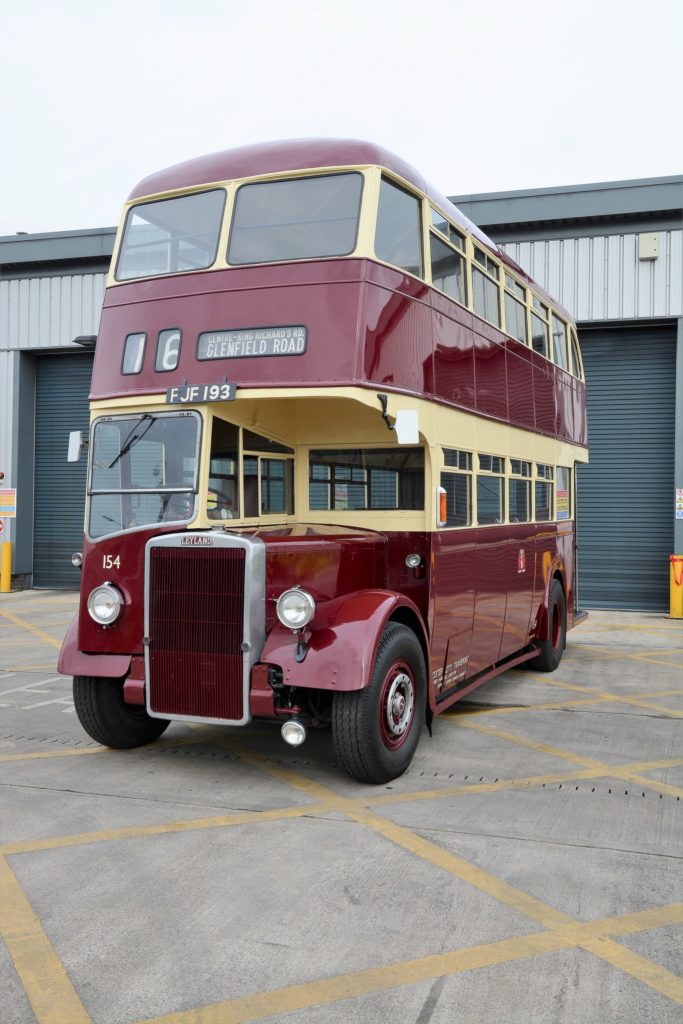
The bus itself, numbered 154 in the fleet of Leicester City Transport, had, by that time, been around for longer than I had. Delivered new to LCT in August 1950, and part of the 160-vehicle post-war intake, this magnificent Leyland Titan PD2/1 was first registered on 1 December 1950. Reports indicate that she may have arrived at Abbey Park Road depot nearly four months earlier on 15 August and placed in storage.
At the time of entering service she had a seating configuration of H30/26R, a standard bus industry code referring to a high-bridge double-decker with 30 seats in the upper saloon, 26 in the lower and a rear entrance.
In March 1954 she received a recorded ‘Touch-up and Varnish’ to her external paint-work. In December 1955 she was re-seated to H33/28R, the work being carried out by Charles H Roe of Leeds for the sum of £95. It’s not clear whether she made the trip to Leeds for the work but squeezing in the extra three seats on top, and two below brought the seating capacity up to 61. This was deemed necessary because of the continuing growth in passenger numbers, with this solution being the most economical way of combating the problem.
In February 1956 she was involved in a serious road accident with an army lorry in the city centre at the junction of Granby Street and Horsefair Street. Photos of the battered front end made the front pages of the local papers.
Clearly keen to get even more capacity out of the bus, in 1957 LCT took the decision to change the seating configuration again, this time replacing the front two pairs of seats in the lower saloon with a five-seat, rear-facing bench seat. The cost for this piece of work is recorded as being £40, the work being carried out at Abbey Park Road. 154 could now carry 62 seated passengers, a figure that has remained the same to this day. Reports indicate the bench seat wasn’t popular with passengers given that the 26-foot length of the bus resulted in a very cramped space!
In January 1958 she received her first full repaint, retaining the classic post-war maroon livery with cream window surrounds albeit without the orange lining that had been applied when new.
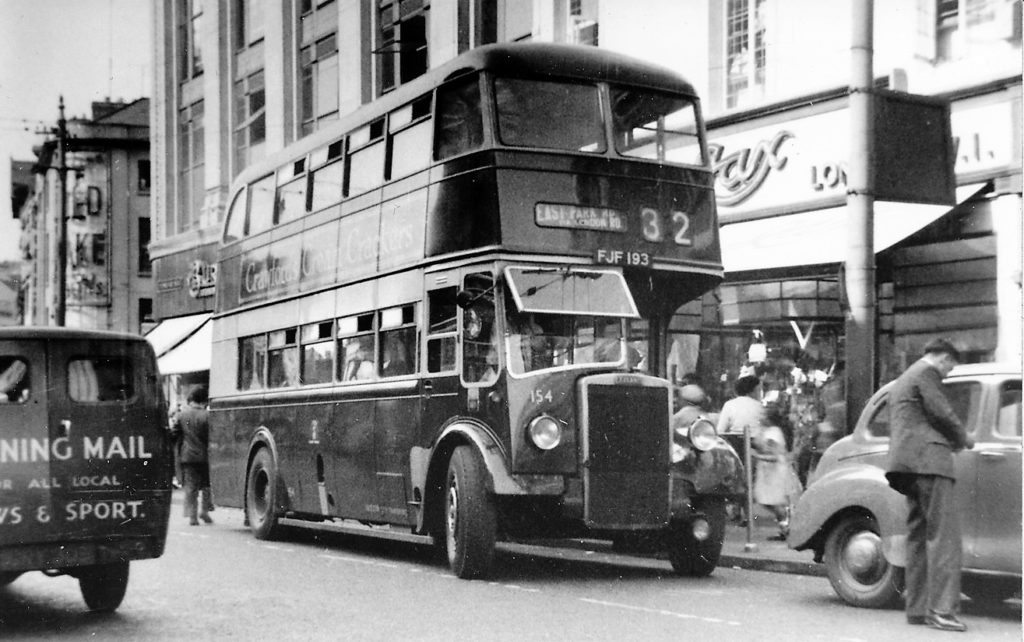
Having spent some seven years from delivery until that first full repaint, it’s perhaps surprising to note that the second full repaint took place just over three years later, in March 1961. It seems reasonable to assume that the growth in the number of motor vehicles on the roads during that period had had an effect. It’s also believed that buses were no longer being varnished as part of the repainting programme. It’s likely then that LCT felt more regular repaints were necessary to ensure that its reputation as a municipal operator proud of its fleet was maintained.
This second repaint still retained the maroon livery and cream window surrounds. However, it was only two months later that LCT changed the fleet livery to the predominantly cream livery with crimson relief. The honour of being the first to wear the new, brighter livery, went to AEC Bridgemaster 214 (VJF 214), outshopped on 5 May 1961 and launched at that year’s Lord Mayor’s Show.
Some might question why LCT didn’t hold 154 and her sisters and put them through the paint shop later so they could carry the new livery. The answer lies primarily in the need for the paint shop to maintain its programme of repaints. The painting of 214 was also an experiment by LCT to gauge reaction and see how the lighter colours stood up in service conditions before the new livery was rolled out to the rest of the fleet.
In fact it wasn’t until eighteen months later, on 23 November 1962, that the second bus, sister Bridgemaster 213, emerged from the paint shop in the new revised cream livery. The paint shop records then show that whilst Leyland PD3s, Daimler CSG6s, Leyland PD3As and the rest of the Bridgemasters were repainted cream, the next 45 PD2s through the paint shop continued to be repainted in the old livery!
The turning point came in late 1964. On 20 November bus 140 was outshopped in the old livery, and then, on 30 November, bus 141 became the first PD2 to appear in the revised cream livery.
154 received her cream livery in March 1965, with a further repaint, into the same livery, being completed in March 1968.
But the writing was on the wall for 154. She had performed admirably, and was no doubt looking forward to her 20th anniversary of serving the people of Leicester.
But the celebrations were never to happen. On 27 March 1970, 19 years, three months and 27 days after entering service, she was withdrawn. She was one of the final Leyland Titan PD2s in service in the LCT fleet.
Demonstrating the changing times she was officially ‘replaced’ by a Bristol RELL/ECW single deck, one-man-operated bus. Younger readers may question the term ‘one-man-operated’. The answer is simple. In those far off days, it was very much a male-only occupation, and the terminology reflected it.
Running on strawberry juice
Parked on the garage forecourt at Abbey Park Road, 154 awaited her fate. She didn’t have to wait long. In April 1970 she was sold, along with sister 155, to Barnsley dealer Fisher & Ford who, three months later, sold her to A & H.A. Scutt of Owston Ferry in Lincolnshire. The records show she was acquired for further service, but it’s unclear if that was of the passenger carrying variety or not. It seems unlikely, as you might reasonably expect photos of her ‘in service’ would have survived. However, research does reveal that by September 1971 she was no longer registered as a PSV.
She spent the following three-and-a-half years living this life of apparent mystery before being sold to a farmer, Mr Maw, based in West Butterwick in North Lincolnshire, south west of Scunthorpe and close to the river Trent. In this rural setting she spent six-and-a-half years transporting strawberry pickers, a far cry from negotiating the city traffic of her former home. She was, however, joined by an old pal when Mr Maw also acquired ex-LCT Bridgemaster 214 in 1972.
Eventually, and no doubt prompted by the effect of wind, rain and strawberry juice, Mr Maw decided that both 154 and 214 had to go. You do wonder whether there was any sentiment involved. At this point in her story, 154 had delivered nearly 30 years of faithful service, both to the good people of an East Midlands city, and the good strawberry pickers of rural Lincolnshire. Oh, and the three-and-a-half years of her mystery existence!
It was at this point that local enthusiast and LTHT member John Arnold, an LCT-trained body craftsman who had become involved professionally in classic car restoration, became aware of the location of both vehicles.
He contacted fellow enthusiast Peter Newland (now an LTHT director). Peter takes up the story.
“In the summer of 1981 four of us visited Mr. Maw the farmer in West Butterwick,” he says. “I went up with John in my Triumph Dolomite, and Mick Gamble, Brown’s Blue owner (and now LTHT member) went with his friend Tony Sewell in Mick’s Singer Vogue. We inspected 154 and Bridgemaster 214 but sadly the latter was in very poor condition. 154 was in much better shape, considering it was by this time over 30 years old, and we all thought it deserved a chance to be saved.”
However, in September 1981, and hopefully with a tear in his eye, Mr Maw sold the two buses to the Barnsley dealer Paul Sykes. This time the writing was very much on the wall, and in short order both passed to Mr Sykes’ sibling, Joe, also a dealer.
For most people, perhaps the majority of people, a bus is little more than metal and rubber. But you know, I’m minded to think that some buses have a fairy godmother, because what happened next to 154 (and this is like the story of the ‘Titanic’; the answer is hardly a secret) was simply magical!
But for this writer, heading to Abbey Park Road on that August day in 1983, thoughts of that third stage in the life of this very special bus were hardly front-of-mind. Indeed, the plan was to take 154 for a bit of run out in readiness for the next day when I would be part of the driving team that would take her to Leeds and to the Wallace Arnold depot in Gelderd Road for the start of that year’s Kirklees Rally.
But this isn’t a feature about my rallying days with 154 (Perhaps another day? – Ed), it’s about 154 remarkable life – so let the story continue.
The initial restoration
Having seen 154, John Arnold was keen to try and save her from the cutter’s torch. He initially approached the management of the Abbey Pumping Station Museum. They already had Renown 329 and Willowbrook-bodied PD3 164 on their books, and with 154 having no local connection in terms of chassis or bodywork manufacture they declined the opportunity.
Never one to give up easily John then contacted Mike Greenwood (LCT’s Traffic Officer, Planning and Publicity) to encourage him to talk to Geoffrey Hilditch (GGH), LCT General Manager. The message would be that 154 was too good to be scrapped and that it could, even should, be restored and earn its keep as a heritage vehicle.
I recall (helped by sight of a memo in my collection) of a not dissimilar conversation with GGH about saving ARY 225K Metro-Scania for use as a publicity vehicle!
Mike and John had both correctly recognised GGH’s penchant for preserving heritage vehicles. The answer, eventually, was “yes!”
At the same time, and languishing in the Abbey Park Road depot yard, was Leyland Titan PD3A/1 GRY 63D. This bus, withdrawn in November 1980, had been earmarked for a German buyer (Bruning, Bad Gaudersheim) in January 1981 but the agreed sale price never arrived. GGH instructed Mike to talk to Joe Sykes and tell him that he would exchange 63 for 154 and a small amount of money. Joe was having none of this and told Mike to tell GGH that he would take 63 and “some money” in exchange for 154!
A bit more sabre rattling, with Mike acting as the go-between, took place before Mike, somewhat bravely, suggested to GGH that wouldn’t it be better if he spoke to Joe Sykes direct! This did the trick.
There’s doubt about what the final deal was, but Mike got the impression that both parties thought they had got the better deal!
The formalities were completed on 18 November 1981 with 154 returning to Leicester on Thursday 19 November. It seems likely that she was probably delivered by a suspended tow on one of Joe Sykes’ wagons. 63 wasn’t in a fit state to be driven either so it’s also likely that she would have been the return load on Joe’s wagon. Sadly no photos exist of those movements, so far as we know, but one might picture the moment.
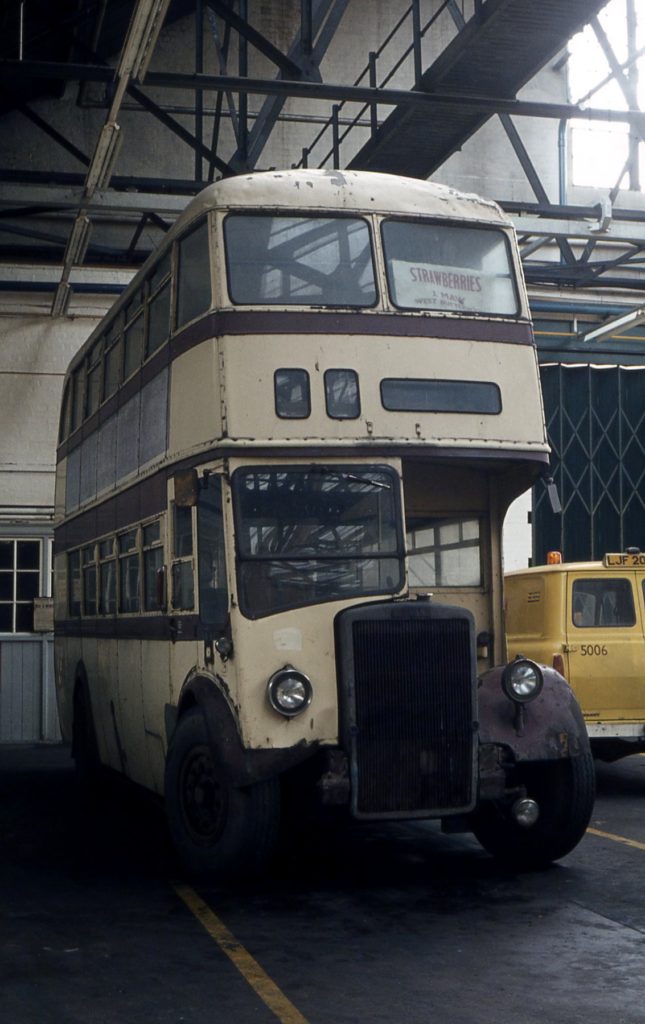
Except that one member of the LCT team wasn’t quite as fully briefed about the project as you might expect.
Maurice Darnes was Body Shop Superintendent at Abbey Park Road and he takes up the story.
Quite a project!
I knew nothing of the discussions that were taking place to bring 154 back to the transport workshops to be completely overhauled for preservation (says Maurice). That was, until 5 November 1981 when I was in conversation with GGH. He had asked me to meet him that particular afternoon to discuss the details of a future workshop project. At the conclusion of the meeting I was informed that there was a possibility of an ‘old Leicester’ vehicle being acquired, and should the outcome be positive, what were my thoughts for a major overhaul of a vehicle to bring about a high quality restoration project.
My answer was that we had all the facilities, skills, and the employee technical knowledge to carry out the task to bring the project to conclusion.
“Good!” was GGH’s reply, “I shall keep you informed of all the details and speak with you at a future date. I shall not be in the office throughout tomorrow!”
Those words were significant, as the next day I was approached by a workshop employee (a labourer) who told me that “one of the old PD2s was to be purchased and it was to be completely overhauled.”
My immediate thoughts were that someone, somewhere, had more information than me, and after the following weekend, when GGH came into my office, I informed him of my findings.
He wasn’t pleased, but he informed me that he had been speaking to other ‘higher management’ personnel and it was evident that “words had flowed” when he had specifically asked for confidentiality.
That Monday afternoon GGH asked me to his office and he confirmed that a PD2 was to be purchased, and that within a fortnight the vehicle could be on the premises.
The initial planning was that the vehicle should have a thorough examination. If the statements coming forward from enthusiasts that had seen the vehicle were confirmed, then it was in a shocking and filthy condition, and a total steam-clean of the interior and exterior of the vehicle should be carried out.
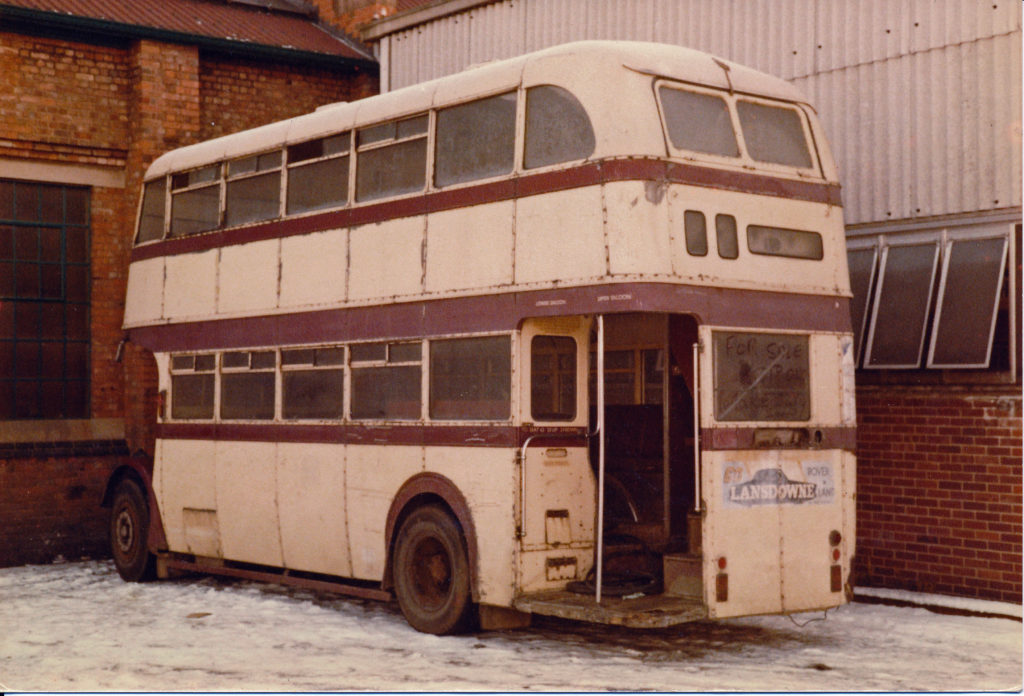
When 154 subsequently arrived and had been suitably steam-cleaned it was found to be in a disgraceful state. It was placed into the body shop on the first vehicle pit. It was stripped to its main frames for examination, a process that showed we were missing many parts from the original vehicle that had been sold.
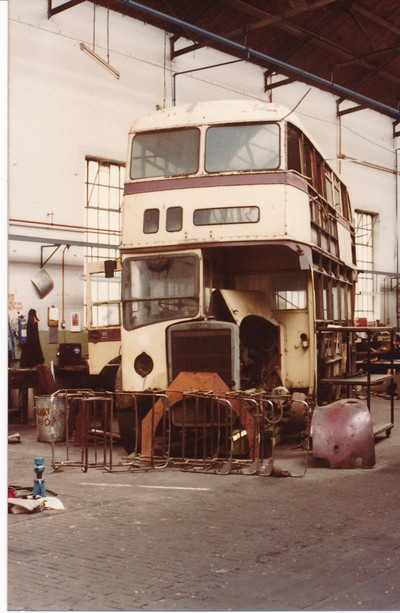
After discussion with GGH he arranged that a full list of wanted parts be supplied to him and he would take it further. At this stage 154 was allocated the affectionate name of ‘Strawberry Fields’.
Scrappers save the day
Some days later he called me to his office and said that myself and another member of the bodyshop staff should make arrangements to go to Beresford’s scrapyard, near Leek in Staffordshire. We were to spend a full day there looking at the many old and scrap buses, some which were nearly intact Leyland-bodied PD2s.
I arranged a date with Beresford’s and booked a works van for the day. The chosen person to accompany me was Phil Andrews.
We travelled up to Beresford’s and met with the boss who, we discovered, knew GGH well. We were told we could go wherever we liked in the yard and take as much as we could to try to complete the list of parts we required.
By 3pm the list of parts was complete, except for an upper saloon front handrail. We needed one because 154 was sporting a bent scaffold pole! I insisted the one we needed was black, with black fittings, and NOT stainless steel which many operators preferred. There wasn’t one!
Eating a snack in one of the ‘scrappers’ we realised the sky was becoming a rather worrying black colour.
Phil said he was going to go to the very far edge of the scrapyard and double-check to see if there were any more PD2s, possibly ones we had missed. I started to load the Ford Escort van and soon realised that we had many parts, large and small, short and long, and the longer ones were only just fitting the van interior.
Phil had been away some fifteen minutes when I heard a shout from the distance. He had located a PD2 on the far side of the yard, hidden from my view. I can’t recall the operator, but it had a black front handrail, intact with all its fittings and in good order!
It was a good find on Phil’s part and out came the screwdrivers to see if we could remove the handrail. No! All the machine screws were seized solid. I decided to remove the front glasses (ideal to take back for LCT’s stock) and cut the three front pillars, leaving the handrail fixings intact.
It was at that point that the rain arrived, and I do mean rain! The front nearside and offside front ‘D’ lights were missing and because we had removed the two front glasses earlier we were open to all that the British weather could throw at us – and throw at us it did!
We were both open to this deluge but Phil remembered that the vehicle behind us had some reinforced plastic sheet stuffed under its rear staircase. He went and collected it and positioned himself and the plastic around our vehicle’s front upper saloon to protect us. I thought I had the difficult job of sawing through the front pillars, but no, Phil had an even more difficult task keeping the sheet around and in front of us to try and keep us both dry.
We both managed to remove the handrail intact, and without damage. Sadly, we weren’t quite so fortunate and returned to Beresford’s offices soaked through to our under clothes.
“You’re not nicked!”
Fortunately we had taken a change of attire, so changed and having given our thanks to all concerned we started our journey back to Leicester. Being hungry we stopped at a ‘Little Chef’ for a well-earned meal.
Whilst we were eating, two police officers came into the restaurant, no doubt on their break from duty. Phil nudged my arm and said I should look at our van. To my horror the front bonnet appeared to be pointing towards the sky. Well-loaded was an understatement. I began to think that after our very successful day we were about to feel the heavy hand of the law upon our shoulders.
The two officers came over and sat near to us. We started chatting (well, it was 1981!). They pointed to our van. I explained where we had been. To our surprise one of the officers revealed he was very interested in vehicle preservation so we found ourselves discussing the subject further.
They finished their meal, shook hands with us both, wished us well and hoped we had a good journey back to Leicester. Fortunately the ‘Rocket Escort’ wasn’t booked.
At 7.40 the next morning we received an early visit from GGH. He looked at everything we had brought back saying: “You both had a good day then!”
I told him that our wet clothes were at home! He walked away and immediately went to speak to Phil where I noticed he shook hands with him and had quite a long chat. He was clearly a pleased man. Despite his 154 being in a disgraceful state his parts were here.
It’s worth pointing out that the entire job of restoring 154 was undertaken in spare workshop time, the workshop team always keeping busy and showing their expertise in getting buses back out to serve the Leicester public.
The team gets stuck in
During overhaul 154 was rebuilt throughout its framework. It was fitted with a brand new rear bulkhead, new entrance platform, new staircase, rear upper saloon emergency window, all new window panes, lower saloon floor and front bulkhead mountings. The front destination blind layout was NOT allowed to be reversed to when 154 was originally delivered to LCT.
Glazing was retained as were the cab fittings which were overhauled as necessary.
The body overhaul was undertaken by many workshop personnel, but special acknowledgement must go to Gilbert Hand, my chargehand, a gentleman who knew everything about the PD2 body-wise. His recent passing aged 94 has greatly saddened me.
Names I must mention are Mark Gretton, Gary Henshaw and Keith Robinson for the sheet metal and panel beating expertise, Graham Konter and Alec Dormer for their body construction skills and the brilliance of George Place the blacksmith, for everything that needed ‘hitting hard’ to manufacture. Many other bodyshop personnel were involved, too many to remember at this time. Sadly Graham Konter has passed away, but with his Willowbrook skills he was an excellent craftsman.
The seat trimming was brand new throughout in LCT maroon leather, expertly trimmed by
Doug Tams and Lee Tyres. Two new front wings were also made. Mechanically, all parts were removed where possible and inspected, many of them receiving a full overhaul at that time under the sole charge of Gordon Wells, the fitting shop Superintendent and his staff.
Mention must be made of the LCT cleaning staff. Most items from Beresford’s together with those fittings removed from 154 when it was stripped of parts, especially the seat frames, were individually cleaned by these personnel.
Lovely orange gunge
A special point in question was that of the dreaded front upper saloon handrail which came out of LCT storage smelling and covered with a very thin layer of orange gunge.
It was a nicotine coating from the heavy smoke-filled atmosphere of the upper saloon when the donor vehicle was in service. This task was allocated to Val Tebbut, (a lady I must mention as her name is very significant to me at the time of my writing this article). Val showed me the cloths she used to clean this handrail and the soiling from the item, and together with the time it took to clean, it had to be seen to be believed. In total though an excellent job was done by Val and every member of the superb team she worked with.
The final workforce effort was by the paint shop under the charge of Brian Hulme, Paint Shop Superintendent, and his staff. Original paint colours, transfers and varnish were all sourced by Brian and a fantastic job was completed under his leadership by all the paint shop personnel.
Proof of the high quality completion of 154 by every department of LCT were the many accolades and trophies the vehicle received from rallies, shows and social functions around the country, especially the preservation groups and restored vehicle societies.
After 37 years of preservation 154 has now completed its second overhaul. It’s truly heartening to see people including Gary Henshaw, Ian Killingworth and Andy Harding, who were familiar with 154’s initial preservation work, remaining in First Leicester’s employment and involved in this project.
To them all I extend my very good wishes and the very best to 154 ‘Strawberry Fields’ for another 37 years!’
The third age of 154
Maurice’s recollections really bring this part of the story to life, and thanks must go to him for taking the time to put them together. Thanks to the skilled and really rather impressive team at Abbey Park Road, a fully restored 154 was outshopped in June 1983. As an added note, Maurice recalls that once complete the bus was road tested up
Anstey Lane, a road he describes as “the old stamping ground for newly mechanically overhauled buses.”
Somewhat surprisingly, the actual date when 154 made its debut into the daylight isn’t recorded, and so as far as we know, no photo of that moment exists. However, GGH was keen to show 154 to the world, and it wasn’t long before an opportunity arose.
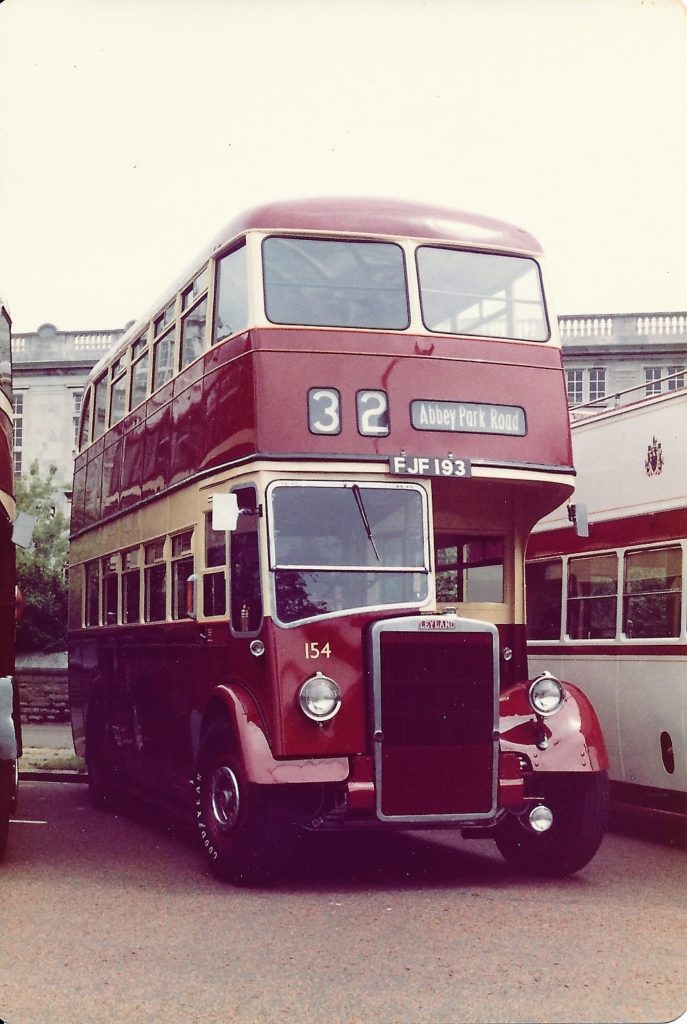
1983 was the 100th anniversary of municipal passenger transport and this important milestone was to be celebrated, in Cardiff. If memory serves me well, GGH, having had an illustrious career in the municipal sector, was keen to support the anniversary. Regardless of the fact that such a long run for the newly restored Leyland might be one step too far, both mechanically and potential body damage from road chips, he decided that 154 would make its industry debut in the Welsh capital.
On Saturday 25 June 1983 a convoy of buses left Leicester. Leading the way, and being driven by GGH, was 154. Following along were AUT 70Y, an East Lancs-bodied Dennis Dominator, XJF 92Y, a Duple Dominant-bodied Dennis Falcon, LJF 16F, the much-missed East Lancs Leyland PD3, and BUT 25Y, a Plaxton Paramount-bodied Dennis Dorchester coach. The following day, Sunday 26 June, 154, together with its entourage, lined up near the Cardiff council offices. GGH looked suitably pleased.
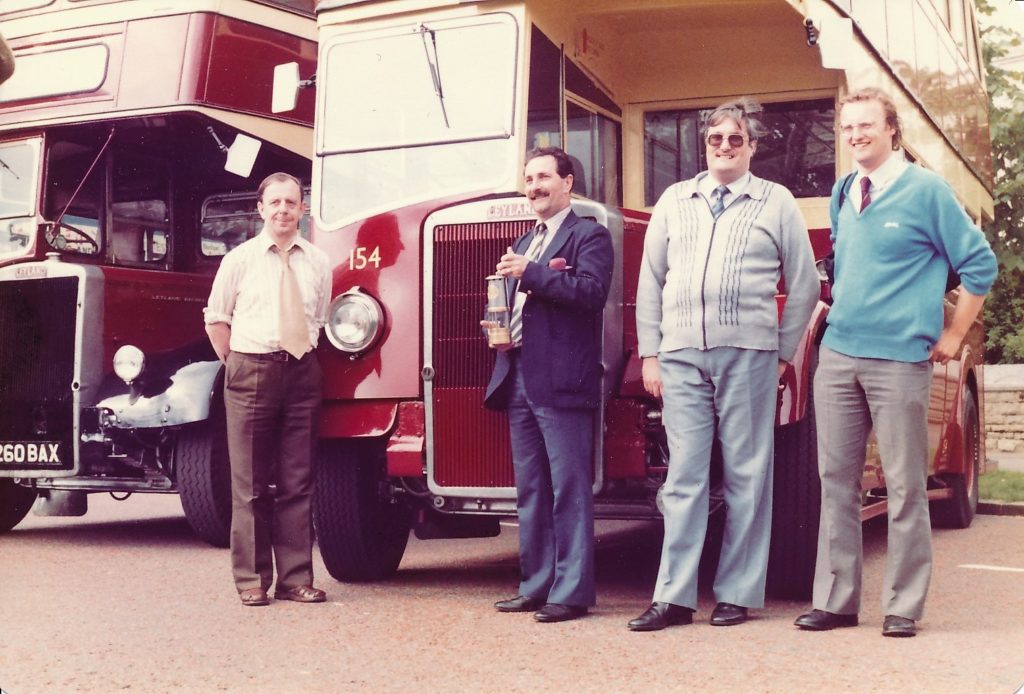
To complete the Cardiff story, Plaxton Paramount-bodied Leyland Tiger coach BUT 18Y was also in attendance having left Leicester very early that morning on an enthusiasts excursion.
It’s worth noting that 154 made the return journey without any hiccups, GGH always leading the convoy, and woe betide any of the drivers should they overtake him!
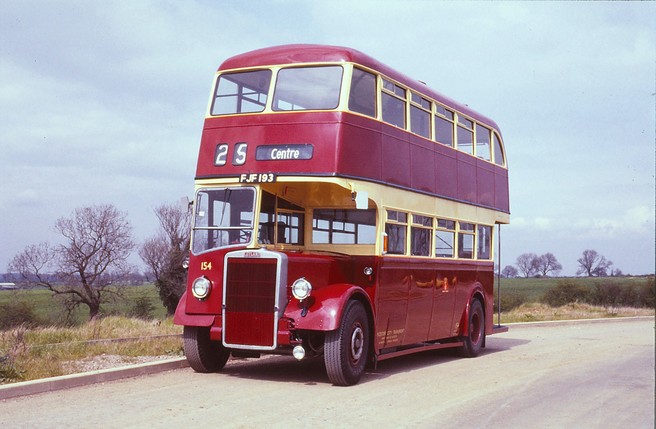
In the following months and years 154 lived up to the purpose that Mike and John had proposed to GGH back in 1983. The bus became popular for private hires, appearing at school events, open days and other events in Leicester as well as occasionally appearing in service. With a welcome nod from GGH, the ‘154 Preservation Group’ was formed. Led by LCT employee Phil Spencer, this group of LCT staff looked after the bus, taking her to rallies across the country where she was often the star attraction, winning a veritable plethora of awards.
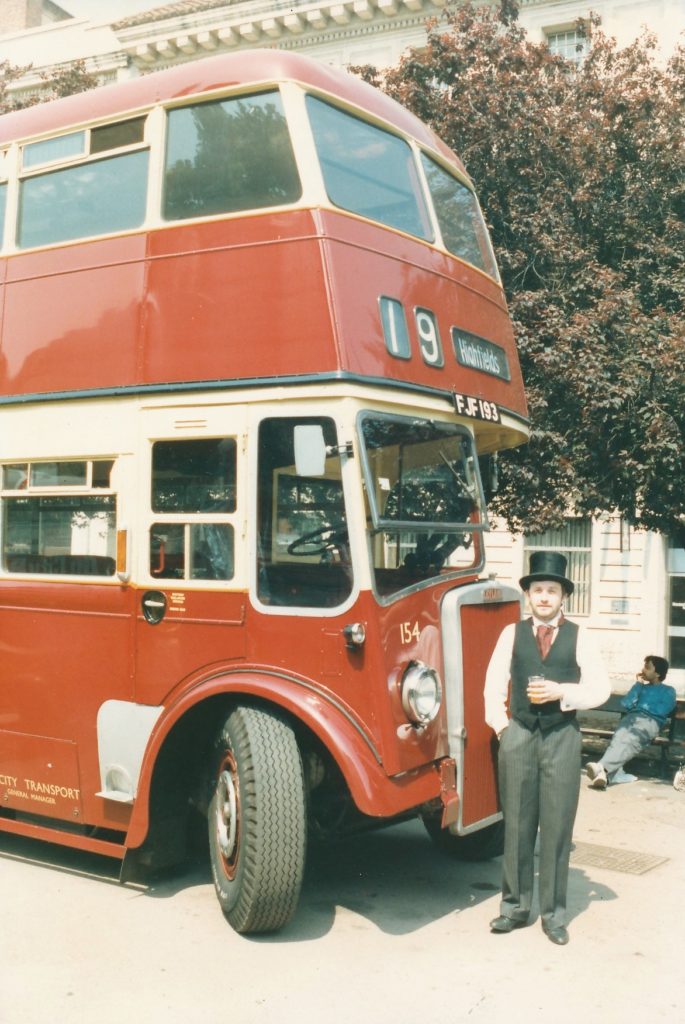
But, as in 1970, times were changing. In October 1986 she transferred with the rest of the Leicester CityBus fleet (as LCT was now known) to Leicester CityBus Limited, the new arms-length company set up by the city council, with 8% owned by Trent.
In November 1993 the city council ownership passed to GRT Holdings plc which in turn, merged with Badgerline Group in June 1995 to become FirstBus plc, and then FirstGroup plc in December 1997. Under FirstGroup she was allocated fleet number 90252 in the national numbering system, but, fortunately, never had to carry it!
154 enters preservation
In June 2008, with FirstGroup looking to dispose of this ‘non-standard’ vehicle, 154 was acquired by Andrew Harris, a local preservationist. In the November of that year LTHT member Simon Gill became part owner, taking full ownership in June 2009. In April 2015 he offered 154 to LTHT. It’s worth stressing that without the sterling enthusiasm and commitment from these individuals, 154’s future would have been bleak indeed.
By 2017 the bus was in need of a major body and mechanical overhaul. First Leicester, as a result of the close relationship with LTHT, offered to undertake the work as part of an apprentice training scheme. As Maurice Darnes mentioned above, in 2017 a handful of the people who worked on 154 in the early eighties were still employed by First. This produced the unique situation where those men who had worked on the bus then were now able to teach new apprentices body building and mechanical skills on the very same bus they had learnt on!
On Wednesday 4 March 2020, the newly restored 154, with LTHT chairman Richard Worman at the wheel, emerged from inside the First Leicester workshops at Abbey Lane depot to the applause of assembled guests.
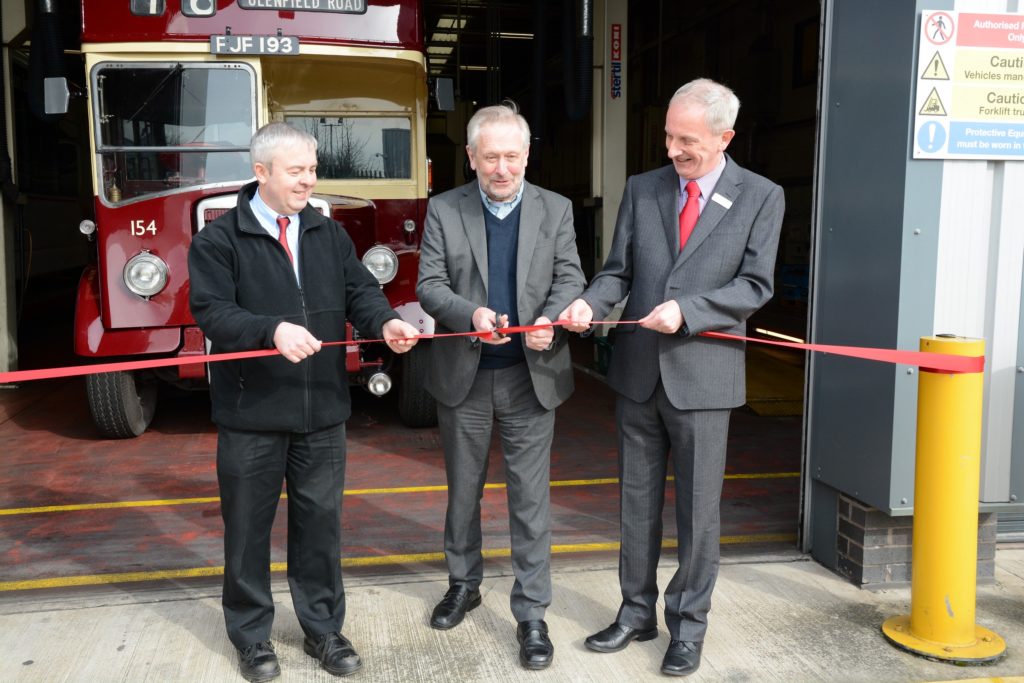
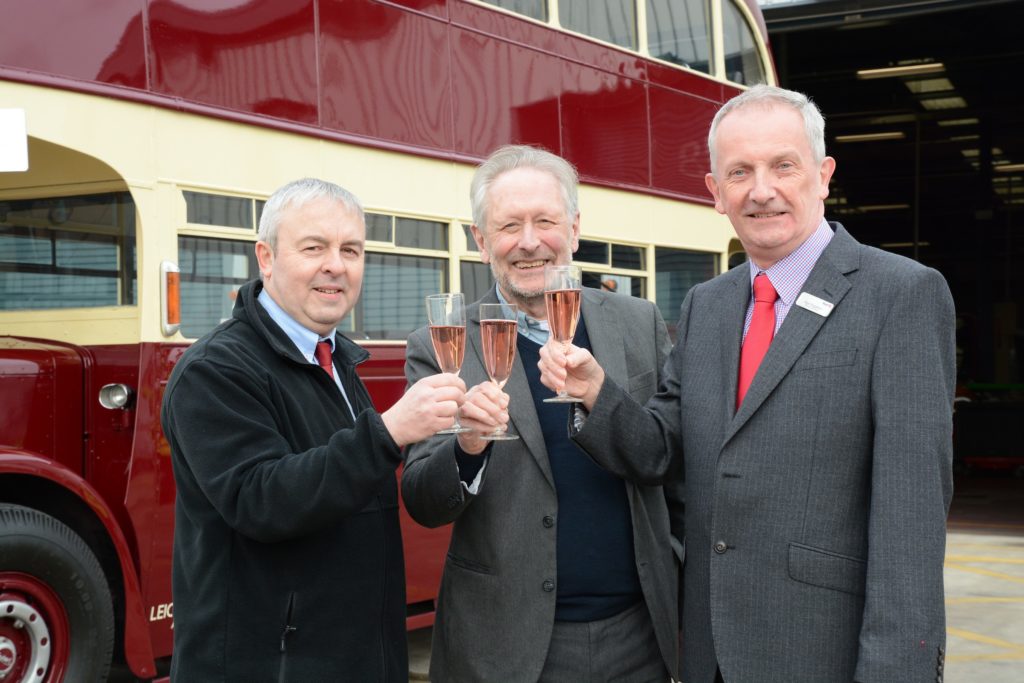
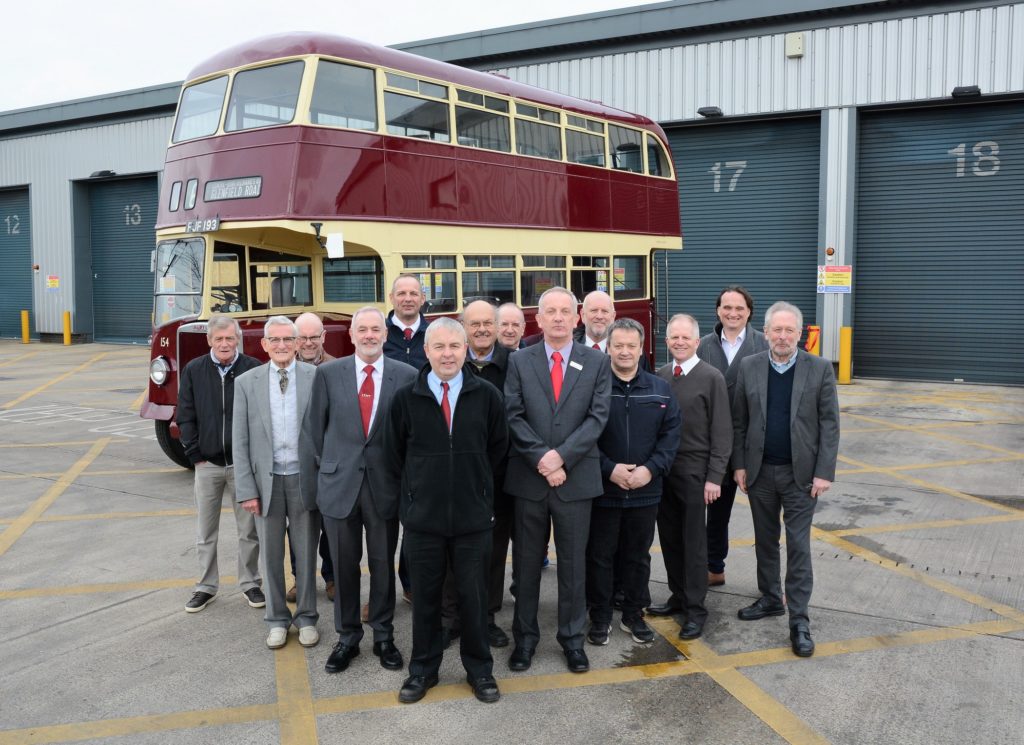
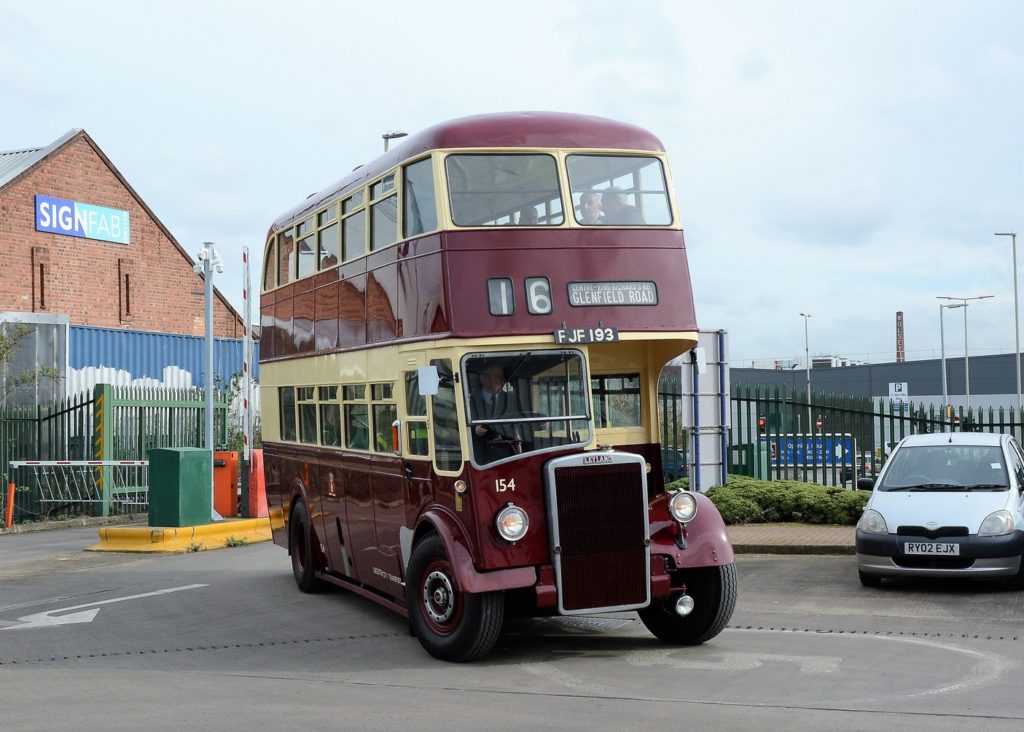
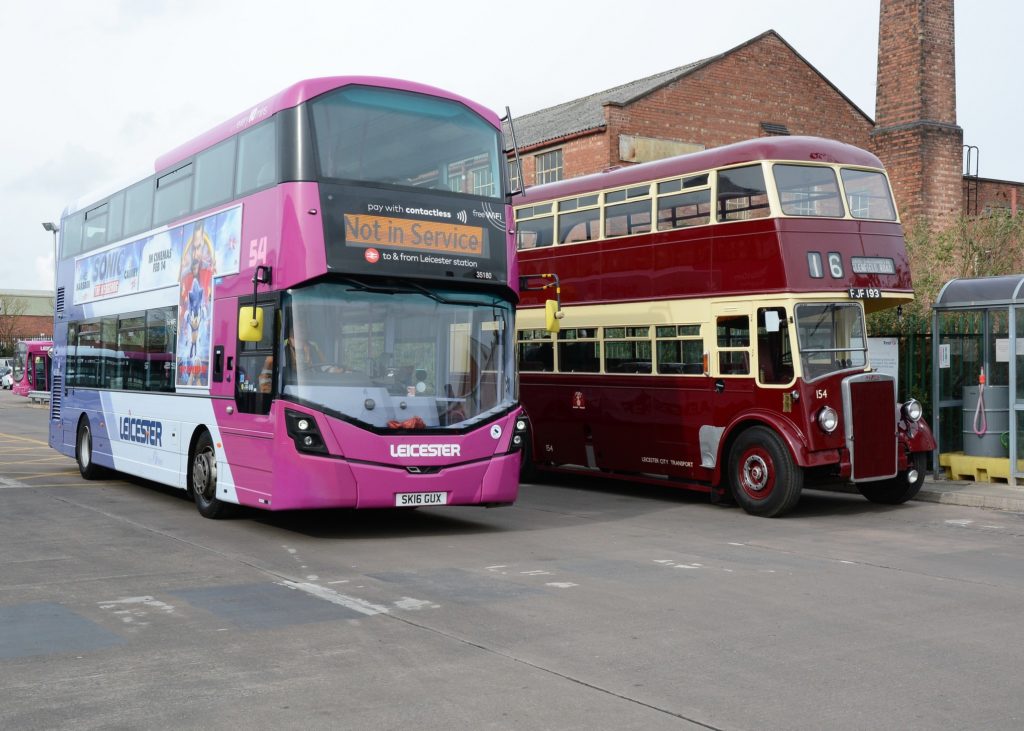
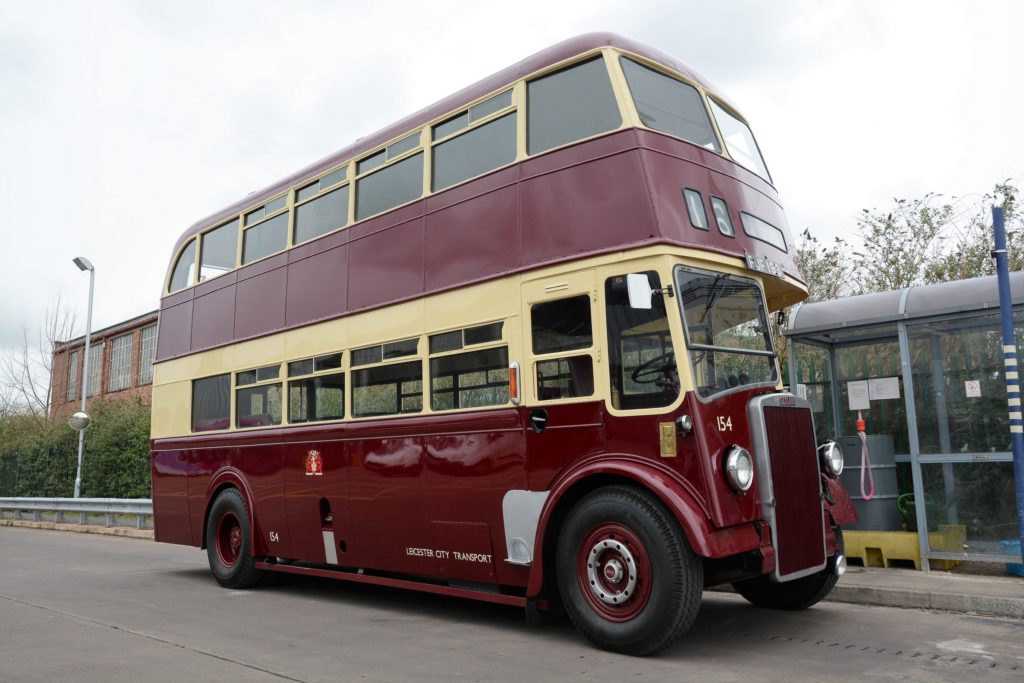
Some 69 years and three months after entering service with LCT, the grand old lady had returned, ready to start her fourth life, and looking forward to her 70th birthday on 1 December 2020.
In ending this story, and because I’ve spent a good part of my life behind the wheel of 154, it feels only right to offer a huge thank you to each and every person, many no longer with us, who have played a part in what has been, and continues to be, the remarkable story of 154.
This feature was originally written for ‘Wheels’, the quarterly magazine of the Leicester Transport Heritage Trust. For more information about the LTHT, go to www.ltht.org.uk



